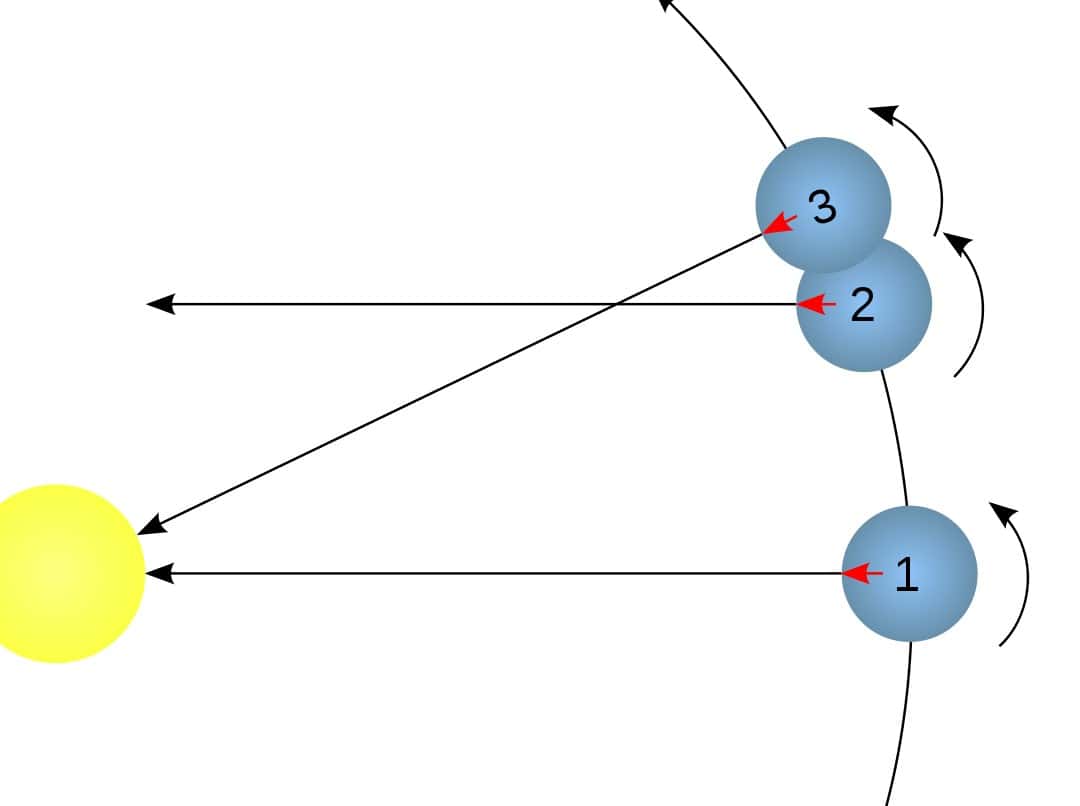Greetings.
The time period from 00:00 to 06:00 is considered nighttime, while the time period from 12:00 to 18:00 is considered daytime.
Have you ever wondered why midnight is at 00:00 and noon is at 12:00? If we take a literal approach, midnight would actually be at 03:00 and noon would be at 15:00. So, why is there this discrepancy?
Midnight can be defined as the time when the sun passes through the meridian based on the accepted time zone, or astronomically for a specific location as the moment when the center of the true (average) sun reaches its lowest point in the sky.
Noon, on the other hand, originally referred to the middle moment of the day, occurring between sunrise and sunset (half of the day, noon). Nowadays, noon is commonly understood as 12:00, the middle of the day.
It was simply a convenient convention that stuck over time.
- Homepage /
- Educational Information /
- Astronomy Facts /
- The True Solar Day. True Solar Time
Related articles
Ships’ Approach and Departure from the Ship’s Side or the Wall (Berth, Pier)
Calculating the Distance to the Target by Maneuvering a Submarine
Project 685 “Fin” Submarine (“Mike”)
Leave a comment
Most Popular
Advanced Isolating Breathing Apparatus IDA-59M
The IDA-59M Isolating Breathing Apparatus (figure 9) is a self-contained breathing apparatus that uses a closed breathing cycle. This apparatus effectively isolates the body’s organs…
Techniques for Artificial Lung Ventilation and Closed Chest Compression
In various emergency situations, when an individual is not breathing and shows no signs of heart activity, it becomes necessary to initiate artificial lung ventilation and closed…
The Volkhov submarine, positioned underwater, fired a Kalibr cruise missile at a surface target located in the Sea of Japan.

The Bratsk nuclear submarine has been deemed unsuitable for repair and will not be restored

In the autumn of 2020, the Russian Navy will receive the first multi-purpose nuclear submarine of the upgraded Project 885M, known as “Yasen-M”, named “Kazan”.

Commemorating 115 years of Pacific Fleet’s submarine forces
The Pacific Fleet’s submarine forces in Russia marked their 115th anniversary. The first squadron of submarine “destroyers” emerged in Vladivostok in 1905.

The crew of the submarine Dmitrov, belonging to the Baltic Fleet, has commenced the execution of combat training assignments and the practice of standards.
Time has always held a significant position in the history of humanity. In the realm of astronomy, as well as in every other domain, time assumes a crucial and captivating role. It represents the duration of any given activity and serves as a measure of life itself. Just imagine if time did not exist, how would we comprehend and define our surroundings?
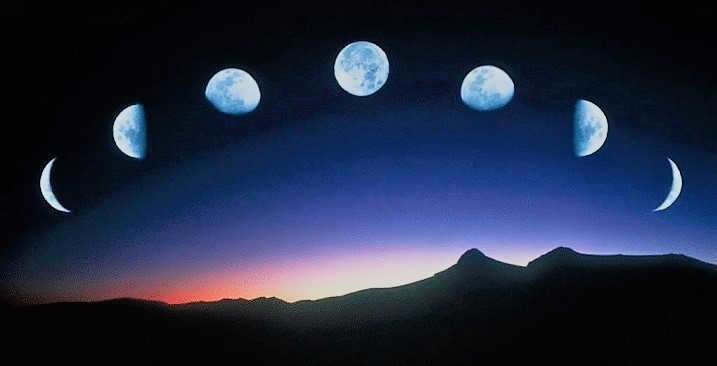
Julian days
Astronomers have adopted a specific sequential numbering system for days. Within this system, there is a 28-year cycle where all days and weeks are repeated.
John Herschel developed this method of time measurement in 1849. The counting of time began at noon on April 1, starting from 4713 BC. Joseph Scaliger proposed the use of this system and named it Julian, in honor of his father Julius.
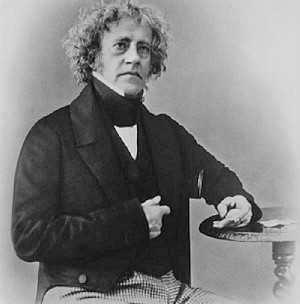
Astronomical Definition of Universal Time
A sidereal day is the time it takes for two consecutive peaks to pass.
In the field of astronomy, universal time can be defined as the hour angle of the vernal equinox point. In addition, sidereal time is calculated based on this point.
Stellar days represent the duration of the Earth’s rotation around its axis, and they are divided into hours, minutes, and seconds. One year has one additional stellar day compared to the average solar year.
It is evident that the sidereal day is shorter than the average solar day, with a difference of 3 minutes and 56 seconds.
Furthermore, the time it takes for the Earth to complete one revolution to the vernal equinox point remains constant, resulting in a constant day.
Solar time in the field of astronomy
Sidereal time is widely used in the study of celestial bodies, but it is not practical for everyday human life. As a result, the concept of solar time was introduced.
This form of time measurement is determined by the change in the sun’s hour angle.
This method of calculating time is based on the interval between two successive solar culminations. It is important to note whether these culminations occur at the highest or lowest point, as this determines whether it is midday or midnight.
Solar time varies depending on the specific Sun it is based on, making it both true and average.
The true solar day is defined as the duration of the Earth’s rotation in relation to a particular Sun.
This day begins at true midnight, which is when the Sun reaches its lowest point in the sky.


The motion of the Sun is not consistent. Consequently, the duration of a solar day on December 22 is longer than on September 23 by nearly one minute. However, this inexactitude poses an inconvenience for time calculation.
In our daily lives, a day is composed of 24 hours. Generally, time is measured in seconds. Furthermore, to determine the time, individuals differentiate between morning, afternoon, evening, and night. This differentiation primarily depends on the Sun’s position in relation to a specific meridian.
Nevertheless, the mean solar day is utilized to precisely ascertain time. It represents the duration between two successive culminations of the average equatorial Sun on a given meridian. It is more accurate to state that the mean solar day corresponds to the average of the true solar day.
The Sun’s movement along the ecliptic is characterized by an average speed. This convergence occurs around January 3 and July 4.
The equatorial path of the Sun is also consistent, but it aligns with the ecliptic Sun specifically at the vernal equinox. The average equatorial position of the Sun remains constant and uniform in relation to true solar time.
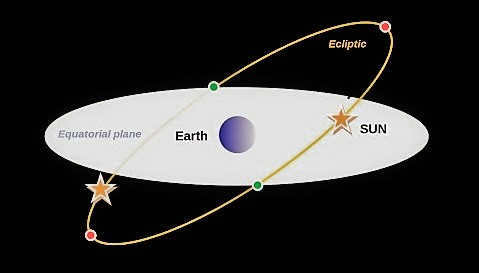
Universal Time
Primarily used in the field of astronomy, Universal Time is a standard for measuring time across the globe.
As we learn in school, the Earth is divided into 24 meridians, each 15 degrees apart from one another.
The main meridian, also known as the prime meridian, is located at zero longitude and serves as the reference point for all other meridians.
Meridians extend from west to east.
Adjacent time zones differ by one hour, allowing individuals to calculate the time in a specific zone by knowing its corresponding zone number.
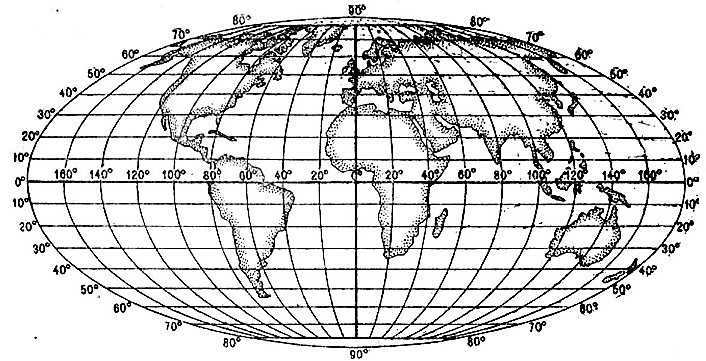
In reality, zone time refers to the time within a specific time zone. It is widely acknowledged that a day is composed of 24 hours and commences at midnight.
Time for Maternity
For instance, Russia is divided into 9 different time zones. In 1930, the notion of decree time was established, which added one hour to the standard time of each time zone.
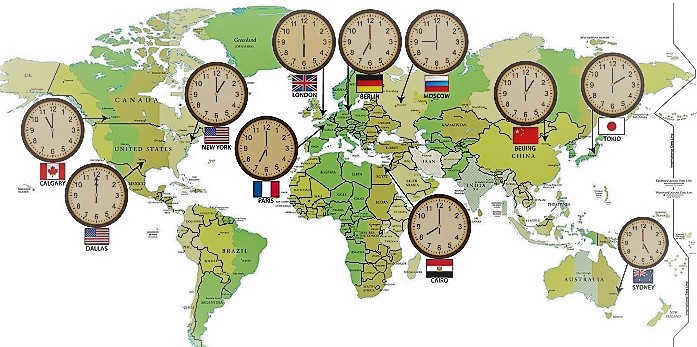
Moscow time is another name for universal time in astronomy.
This designation of time implies the utilization of the time from the adjacent zone. In other words, Moscow time is zone time plus one hour.
According to the recent concepts, it is referred to as local time.
Ephemeris time
Ephemeris time is a time scale that defines seconds. It is not influenced by the Earth’s rate of rotation. This time scale was introduced by J. M. Clemens in 1952.
Ephemeris time remains constant and is used for the convenience of calculations.
Time, as we can observe, represents the duration of events. It is arguably the most distinct and significant quantity that humans have defined. Moreover, there are numerous methods devised for its calculation.

Undoubtedly, time holds great significance for humanity, as it serves as a fundamental component of our lives. The future will reveal what lies ahead in the realm of time.
1. How does a true solar day differ from an average solar day?
A true solar day is the duration between two consecutive climaxes of the Sun’s center with the same name.
An average solar day, on the other hand, is the time interval between two consecutive average noons.
Using true solar days to measure time can be inconvenient due to their irregularity. To address this issue, the mean solar day is employed. True solar days take into account the movement of the center of the solar disk, while mean solar days consider the motion of the mean equatorial Sun.
A sidereal day is the period of time between two consecutive occurrences of the vernal equinox point reaching its highest point in the sky.
3. What is the definition of the equation of time?
The equation of time represents the variation between mean solar time and true solar time at any given moment.
4. What is the meaning of universal time?
Universal time refers to the average solar time at the Greenwich meridian.
The Date Line marks the boundary where a new date and day of the week begin.
The International Date Line stretches through the Bering Strait, crossing the Pacific islands from the North Pole to the South Pole (at the 180-degree meridian).
6. What are the names of the calendar systems and what principles are they based on?
Calendar systems are built upon three fundamental units of time measurement: the average solar day, the synodic (or lunar) month, and the tropical (or solar) year.
There are three types of calendar systems: lunar calendars, luni-solar calendars, and solar calendars.
In a lunar calendar, the year is divided into 12 months, each consisting of either 30 or 29 days. In total, the lunar calendar has 354 or 355 average solar days, making it about 10 days shorter than the solar year.
In the solar calendar, there are 12 months, each consisting of 30 days, and an additional 5 feast days are added at the end of the year.
7. What sets the Gregorian calendar apart from the Julian calendar?
The Gregorian calendar has a different rule for determining leap years compared to the Julian calendar. In the Julian calendar, every fourth year is considered a leap year. However, the Gregorian calendar introduces a new rule: if a year ends with two zeros, it is a leap year only if the number of hundreds in it is divisible by four. For all other cases, the year is not considered a leap year.
8. Why is it impossible to create a completely accurate calendar?
It is impossible to create an absolutely accurate calendar because the astronomical cycles on which the calendar is based do not align perfectly with each other. The length of a year does not consist of a whole number of days and equal months.
9. Determine the disparity in mean solar time between the cities of Grodno and Mogilev.
Coordinates of the cities:
Grodno: $23^h49^m32^c$E;
Mogilev: $30^h20^m41^s$ E.
The mean solar time can be calculated using the formula:
where $λ$ represents the longitude of the observation location, and $T_0$ is the universal time.
To determine the difference in mean solar time (local time) between two cities, use the following calculation: $ΔT_ = T_ – T_.$
10. Determine the geographic longitude of the ship at local noon when the ship’s captain noted 14 h 13 min 46 s on a chronometer going by Greenwich Mean Time.
Local time is the mean solar time, while local Greenwich time is the world time. By using the relationship between mean solar time (T_m), world time (T_0), and longitude (λ) expressed in hour measure, we can calculate the geographic longitude of the ship.
11. On June 22, an observer found that the average local noon happened at 8:40 a.m. Coordinated Universal Time (UTC), and at that moment, the Sun’s altitude was 62°10′. The Sun’s declination on that day was δ = +23°26′. Find out the geographic coordinates of the observer.
By utilizing the equation for determining the upper culmination and referring to the diagram, it can be derived that:
Calculating the latitude of the observer’s location using the equation, we obtain:
The local time corresponds to the mean solar time, while the Greenwich local time corresponds to the Coordinated Universal Time (UTC). By using the formula that relates the mean solar time Tm, the universal time T0, and the longitude λ expressed in hours, we can derive:
Most people don’t often contemplate the nature of time. They simply rely on their clocks, which are synchronized with TV or radio broadcasts. However, even these clocks need to be calibrated. This is accomplished through the accurate time signals transmitted by astronomical observatories, which in turn measure time against the stars. Astronomical observations are conducted using sidereal time.
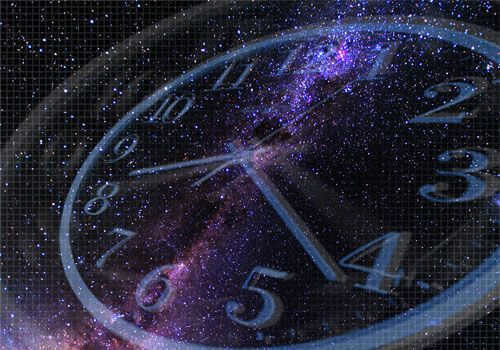
STAR TIME
Star time refers to the time that is determined by the Earth’s rotation with respect to a specific point on the celestial sphere, known as the vernal equinox. Each sidereal day is the period between two consecutive culminations of this point, and it has been a familiar concept for a long time.
Therefore, sidereal time is the fundamental basis of our time-keeping system, even though many people may not be aware of it, as our daily lives are primarily based on solar time.
The concept of solar time is not completely precise because there exist two types of solar time: true solar time and mean solar time. Belt time is a specific form of mean solar time. To comprehend the meaning of belt time, it is necessary to first grasp the concept of true solar time.
TRUE SOLAR TIME
True solar time refers to the time that is measured by a sundial. On a sundial, it is considered noon when the Sun crosses the meridian. The duration between two successive crossings of the meridian is known as a true solar day.
THE CONCEPT OF A TRUE SOLAR DAY
A true solar day commences and concludes at noon. This traditional method of time measurement has been utilized for centuries due to its simplicity and natural progression. However, in our modern era where precise timekeeping and uniformity are essential, this method is no longer suitable as true solar days vary in duration.
Today, the standard unit of time – the second – is defined by the interval in which there are 9,192,631,770 oscillations of electromagnetic radiation with a frequency equivalent to a specific absorption line in the spectrum of cesium atoms. This method of counting seconds is far more accurate than relying on astronomical observations.
The Sun’s movement across the sky is not constant throughout the year. At times, it appears to move faster or slower, resulting in varying time intervals between two consecutive afternoons. These differences can be as significant as nearly a minute. Consequently, if we were to synchronize our clocks with the Sun, we would need to make small adjustments each day based on its position. This would undoubtedly pose significant practical challenges and inconveniences.
The reason for this phenomenon is the non-circular shape of the Earth’s orbit, which is actually an ellipse with the Sun located at one of its focal points. As a result, the Earth’s distance from the Sun varies, causing variations in its speed of orbit. When the Earth is closer to the Sun, it moves faster, giving the illusion that the Sun is moving across the sky at a quicker pace. This elliptical shape deviates from a perfect circle by approximately 3%. At the point of closest proximity to the Sun, known as perihelion (from the Greek words peri meaning “about” and Helios meaning “Sun”), the Earth is approximately 5 million kilometers closer to the Sun compared to aphelion (from the Latin word apo meaning “from”), while the average distance to the Sun is around 150 million kilometers. In the northern hemisphere, there are roughly 186 days between the spring and fall equinoxes, and 179 days between the fall and spring equinoxes (a difference of approximately 3%). In our hemisphere, summer is approximately one week longer than winter.
MEAN SOLAR TIME
Mean solar time refers to the average solar day, which is determined by averaging the length of a solar day over the course of a year.
When we compare a sidereal day to a solar day, we are referring to the average solar day. A sidereal day is 3 minutes and 55.91 seconds shorter than a solar day in terms of minutes and seconds. A sidereal day consists of 24 sidereal hours, which, like sidereal minutes and seconds, are shorter than their solar counterparts.
To ensure that the day ends at midnight instead of noon, the concept of civil time was implemented. Civil time is determined by adding 12 hours to mean solar time. This means that the civil day begins and ends at midnight. Therefore, if your clock is relatively accurate, it will display the time of the average civil day, counting the hours, minutes, and seconds. However, there is still a complication – while the length of the average solar day remains constant, the exact moment of its beginning and end varies based on the location of observation. For example, when the longitude changes by a quarter of a degree, noon in local civil time shifts by one minute.
Due to this variation, each city and town had its own local time, leading to numerous misunderstandings. This problem was eventually resolved with the introduction of time zones.
We measure our day as starting at midnight, otherwise we would need to eat lunch on Tuesday and finish dinner on Wednesday.
TIME ZONES
The process began with an international congress in Washington in 1884 and spanned several decades, resulting in the division of the globe into 24 time zones, each spanning 15 degrees of longitude (with minor adjustments for practical purposes). Time varies by exactly one hour from zone to zone. The time in each zone corresponds to the mean civil time at the mid-meridian of the zone. At this meridian, the zone time aligns with the local civil time, but at the boundaries of the zone, which are 7.5 degrees away from the mid-meridian, the zone time and local time differ by approximately 30 minutes. On the eastern border of the zone, the zone time is 30 minutes behind the local civil time, while on the western border, it is 30 minutes ahead. This difference is particularly noticeable when determining the time based on the position of the stars, although it may not be perceptible in other cases.
In 1930, the USSR introduced decree time, which involved advancing all clocks by 1 hour. Therefore, decree time is 1 hour ahead of zone time.
Throughout the course of human history, time has played a significant role, serving as the very essence of life itself. Without the concept of time, we would struggle to define and understand the world around us.
The Julian Calendar
Astronomers have devised a particular system for numbering days known as the Julian calendar. This calendar follows a 28-year cycle, during which all days and weeks repeat.
John Herschel developed this method of time measurement in 1849, with the counting of days commencing at noon on April 1st, all the way back to 4713 BC. It was later popularized by Joseph Scaliger, who named it the Julian calendar in honor of his father Julius.
Time of the Stars
The concept of stellar time is based on the hour angle of the vernal equinox point. Sidereal time is measured from this reference point.
A sidereal day represents the interval between two consecutive celestial peaks.
It corresponds to the duration of the Earth’s rotation on its axis and is divided into hours, minutes, and seconds. Interestingly, one stellar day is longer than the average solar day by 3 minutes and 56 seconds. Additionally, the Earth’s revolution to the vernal equinox point always takes the same amount of time, resulting in a constant duration for the day.
Solar time
Sidereal time is commonly used in astronomy, but it is not practical for everyday human life. As a result, solar time was introduced as a more useful concept.
Solar time is determined by the hour angle of the Sun. It is calculated based on the interval between two consecutive culminations of the Sun, taking into account whether these culminations were upper or lower. This distinction determines whether it is currently noon or midnight.
True and average solar time
Solar time can be divided into two types: true solar time and average solar time. The determination of these two types depends on the position of the Sun.
True solar time is based on the Earth’s revolution around the Sun. It starts at true midnight, which is when the Sun reaches its lowest point in the sky.
On the other hand, average solar time is based on an imaginary average sun that moves uniformly along the equator. This imaginary sun moves at a constant speed, unlike the true sun which moves unevenly along the ecliptic. To calculate average solar time, we need to add the equation of time to the true solar time. The equation of time is a value that represents the difference between the true solar time and the average solar time at any given moment. The equation of time is given in minutes and varies throughout the year.
The table below shows the equation of time in minutes for different points in time:
These values fluctuate by only a few seconds each year, due to various irregularities in the Earth’s movement. The true P., or solar noon, aligns with the highest point of the sun during the solstices, specifically around June 10th and December 10th. However, throughout the rest of the year, these moments differ due to the continuous shift in the sun’s declination. Therefore, in order to accurately determine the true P. based on observations of the sun’s equal heights before and after noon (measured, for example, with a gnomon or angular measuring instrument), it is necessary to include the “correction of noon”. This correction is determined by the speed at which the sun’s declination is changing. Additionally, it is important to note that the true P., and even more so the average solar noon, does not evenly divide the daylight hours into two equal parts. In astronomy, the day transitions at mid-P., while in the dormitory, the transition occurs at mid-midnight.
Helpful
Discover the definition of “True Noon” in various dictionaries:
TRUE MIDDAY – (True noon) can be found in True noon. Noon. Samoilov K. I. Marine Dictionary. M. L.: State Naval Publishing House of the NKVMF of the Union of Soviet Socialist Republics, 1941 … Nautical Dictionary
POLDAY – noon or noon (noon obl.), m. noon, polden, m. 1. only ed. The middle of the day, the moment when the sun is at its highest point above the horizon, corresponding to 12 o’clock. It is now noon. V. Kataev. By noon, the wind had calmed down and the weather had cleared up…. … Ushakov’s Explanatory Dictionary
Noon – The moment when the Sun is at its highest point in the sky. There is a distinction between True noon, which is indicated by a sundial, and Mean noon, which is 12 o’clock according to local mean time. The difference between the two is called the equation of time. (Source: Nautical Dictionary)
Noon – This term has other meanings, please see Noon (meaning). Originally, noon referred to the middle of the day, between sunrise and sunset. Nowadays, noon is considered to be 12:00. (Source: Wikipedia)
Noon is the moment when the center of the Sun, whether it’s the true Sun or the so-called midday Sun, is at its highest point for a specific location on Earth. True Noon corresponds to the passage of the true Sun through the meridian, while mean Noon corresponds to the passage of the mean Sun. (Source: Big Soviet Encyclopedia)
True noon is the moment when the center of the Sun reaches its highest point in the sky for a specific location on Earth’s surface. You can find more information about this concept in the Time section of the Big Soviet Encyclopedia.
Alexander Sergeevich Pushkin was born on May 26, 1799, in Moscow, specifically on Nemetskaya Street, in the Skvortsov house. He passed away on January 29, 1837, in St. Petersburg. Pushkin’s father belonged to an ancient noble family, and according to genealogical records, they can be traced back to a descendant who came from a noble lineage. You can read more about Pushkin in the Big Biographical Encyclopedia.
In astronomy, true solar time refers to the local solar time that is determined by the objective position of the Earth in the solar system. This time is calculated based on the position of the sun. For instance, true noon always occurs when the sun crosses the meridian. If you want to learn more about true solar time, you can visit its Wikipedia page.
Local solar time can be defined as the time determined at a specific location by observing the apparent position of the sun on the celestial sphere. For instance, true noon occurs when the sun reaches its highest point in the sky at that particular place on Earth. This concept is often associated with local true solar time. (Source: Wikipedia)
ARMENIAN OBRAYAD refers to the liturgical practices of the Armenian Apostolic Church (AAC). The development of the Armenian liturgical service during the 3rd-4th centuries was mainly influenced by Greek traditions (through Cappadocia) and Syriac traditions (through Edessa and Osroena). (Source: Orthodox Encyclopedia)

I am fond of the project. It has garnered the admiration of 5 members.
In the past, noon used to denote the time in the middle of the day, between sunrise and sunset, when the Sun reached its highest point in the sky. However, with the invention and widespread use of mechanical clocks, noon came to refer to a specific moment in time according to the clock. Nowadays, we refer to noon as 12:00 PM based on the official local time. However, the time indicated by the clock can differ from the actual solar noon. In the system of time zones, the maximum potential deviation of the average solar noon from the standardized 12:00 PM time is approximately ±30 minutes. In reality, the difference between the clock reading at 12:00 PM and the time of the average solar noon can be much greater than the theoretical deviation, sometimes reaching 1 hour or more. This difference depends on the configuration of time zones.
The earliest noon in our country occurs at 11.28 in Naryan-Mar, while the latest is observed at 13.29 in Yuzhno-Sakhalinsk.

Noon, originally a moment in the middle of the day, between sunrise and sunset, is the time when the sun reaches its highest point in the sky – solar noon.
It is also commonly known as noon, the time when the clock shows 12:00 local time, although solar noon can occur earlier or later than 12:00.
It is generally believed that at noon, as determined by the clock, the Sun is always directly in the south, or more precisely, in the southern direction. This belief forms the basis for using the Sun and the clock for navigation.
In the northern hemisphere, it is indeed a fact that the Sun is located in the south at true noon.
Nevertheless, this assumption is erroneous. Today, we will endeavor to comprehend this rather intricate inquiry, centering on scientific evidence and reasoning.
Factors influencing the Sun’s position in the sky
Several elements contribute to the Sun’s location on the celestial sphere at noon. Let us examine a few of them.
Longitude
True (astronomical) noon, or solar noon as it is also known, often does not align with official noon time. To clarify this, let’s first understand the definitions.
Noon, according to official time, is the time of 12:00 determined by a precisely set clock. However, true noon is the exact moment when the sun reaches the highest point in its path of movement, as observed from the Earth’s surface, known as the zenith.
It’s important to note that at the moment of true noon, the sun is directly south for an observer located in the middle latitudes of the northern hemisphere. We will explain why this is the case for middle latitudes later on.
Conclusion #1. The Sun’s daily movement appears the same for an observer on the Earth’s surface, regardless of whether they are in the northern or southern hemisphere. It rises in the east and sets in the west.
It is important to note that time zones are created to simplify timekeeping. Without them, different cities in the same country would have different times on their clocks, which would be inconvenient. Therefore, even if two cities are located in different longitudes, their local time may be the same due to the use of time zones.
Based on the information above, it can be deduced that two observers situated in separate geographic longitudes but within the same time zone may experience true noon at different moments. This discrepancy in the timing of true noon compared to the noon determined by hours can vary by up to fifteen minutes, and in some cases even more, due to the fact that time zones do not always align precisely with longitude and are established based on the political boundaries of the world.
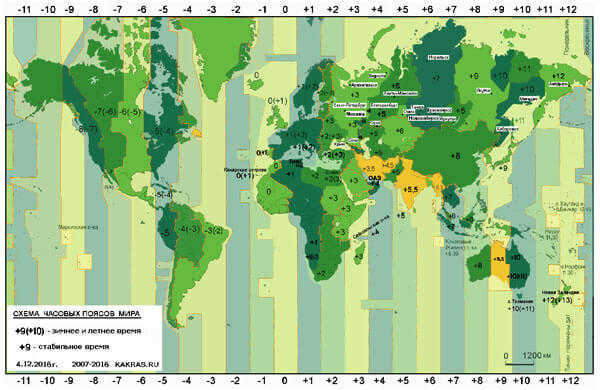

The distribution of time zones across the world map
Furthermore, since the solar noon may not always align with 12 o’clock (referred to as 12:00 hereafter), it is incorrect to assume that the Sun is always directly south at this time.
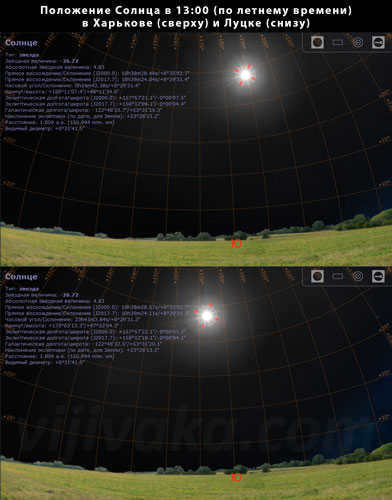

The position of the Sun in the sky can vary at the same time in different cities within the same time zone.
Now, let’s revisit the topic of average latitude and examine its impact on the Sun’s position in the sky.
Latitude of the region
As previously mentioned, in the middle latitudes, the Sun always passes through the southern direction at true noon. However, let’s explore if the situation changes when the observer is located north or south of these latitudes. To analyze this, let’s consider several important scenarios.
Scenario #1 – the middle latitudes of the southern hemisphere. In this case, during true noon, the Sun will be directly in the north.
Regrettably, the fact that the Sun is not only in the south but also in the north at noon is often not included in all tourism textbooks. Fortunately, with the availability of various airlines, modern travelers have the opportunity to explore not only their home countries but also easily venture to the opposite side of the globe, where the conventional orientation rules described in literature may not apply accurately.
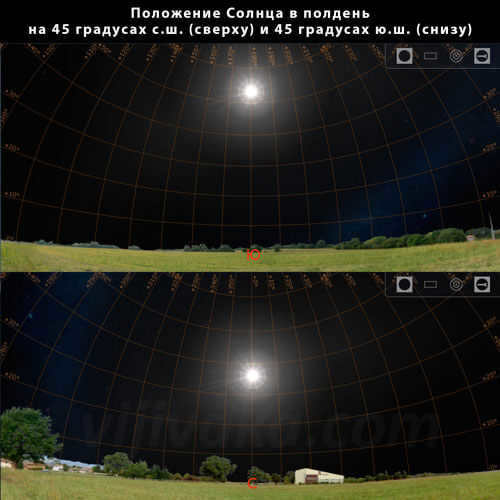
Simultaneously, the Sun will have varying altitudes at the same latitudes in different hemispheres.
Alternative #2 – the northern hemisphere’s tropical zone’s upper limit. In these regions, throughout the year, except for the day of the summer solstice, the Sun will be in the southern direction during true noon, and on the mentioned day – directly above. As you comprehend, it will be impossible to determine the south and, consequently, other directions in the Sun in the latter scenario, if we only consider orienting ourselves using the Sun at noon.
Option 3 – the southern hemisphere’s tropical zone’s lower limit. In this region, except on the day of the winter solstice, the Sun will be in the north at true noon, just like in the middle latitudes of this hemisphere. However, on this specific day in December, the Sun will be directly overhead at the zenith, making it difficult to quickly determine direction.
Option 4 – the equator. In this area, there are three possible variations that change throughout the year. From the autumnal equinox to the vernal equinox, the Sun will be in the south at true noon, and from the vernal equinox to the autumnal equinox, it will be in the north. During the equinoxes, the Sun will be directly overhead, making orienteering challenging.
It has been discovered that the Sun reaches its zenith, meaning it is directly overhead, only once a year at the points where tropical zones transition to temperate zones. As one moves closer to the equator, this occurrence can be witnessed twice a year.


It is nearly impossible to determine if the Sun is directly overhead or not without additional constructions unless you know your exact location on the ground.
It has come to my attention that there is a belief that the Sun is directly overhead at the equator every day at noon throughout the year. However, we now understand that this assumption is incorrect. In reality, the Sun is directly overhead at the equator for approximately half of the year in the northern hemisphere and the other half in the southern hemisphere. Furthermore, even if we define the zenith as the highest point of the Sun’s trajectory (which is also true), the aforementioned belief doesn’t hold much weight. This is because if the Sun were to be in the zenith every day at noon, not only would it be true at the equator, but also at any other location on the planet.
There is a fascinating phenomenon that can be observed in certain tropical cities: around noon, vertical objects like poles and fences appear to stop casting shadows. This occurs because the Sun is directly overhead at that time, causing the sun’s rays and the objects’ shadows to align perfectly. You can learn more about this phenomenon by watching the following video:
One alternative is to explore the high latitudes of the northern and southern hemispheres. In these regions, the Sun will behave similarly to how it does in the middle latitudes. However, during the polar night, it will not be possible to observe the Sun above the horizon and use it for orientation.
It is evident that without comprehending the underlying processes that cause these variations, it is easy to become disoriented and make grave errors, such as mistaking north for south. For a traveler without access to modern navigation tools in remote areas, this can sometimes result in fatal consequences.
Daylight saving time and winter time
Daylight saving time is often implemented by advancing the clocks by one hour. This practice is believed to help conserve electricity used for lighting. However, numerous studies have shown that there is no economic benefit associated with these adjustments. Nevertheless, that is not our current topic of discussion.
Disregarding the clock changes for winter and summer time can lead to a significant error when relying on the Sun and clocks for orientation. In regions with moderate latitudes, this error can be as high as 30 degrees, while in tropical areas, it can be even greater. Just imagine how far off course you can end up if a one-degree deviation results in a deviation of approximately twenty meters for every kilometer traveled towards your intended destination.
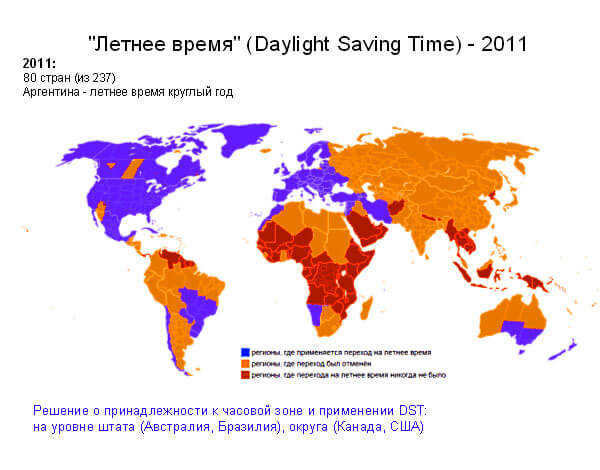
For instance, as of the current year (2017), in Ukraine, noon during the winter months aligns closely with solar noon, whereas during the summer months, the Sun reaches its highest point in the sky around 13:00. In contrast, Russia has abolished the practice of daylight saving time and continues to observe summer time, resulting in solar noon occurring at 13:00 for Russians. However, there are other factors that can contribute to the discrepancy between true noon and the local time’s designation of noon.
Movement of the Sun and the Earth
The Earth’s orbit around the Sun is not a perfect circle; instead, it follows an elliptical path. As a result, the Earth’s distance from the Sun varies throughout the year. During the summer in the northern hemisphere, the Earth is at its farthest point from the Sun, while in winter, it is closer.
Due to this elliptical orbit, the length of a solar day, which is the time between two solar noons, also changes over the course of the year. When the Earth is near the Sun, the solar day becomes longer, while it shortens when the Earth is farther away.
This phenomenon is further influenced by the tilt of the Earth’s axis of rotation.
An interesting picture is obtained as a result. If a person is located at a particular point on the Earth’s surface (for example, the middle latitudes of the northern hemisphere), and marks the position of the Sun on the celestial sphere every day at 12:00 throughout the year, they will observe an elongated figure eight instead of a vertical line (with the Sun being higher in the summer and lower in the winter). This indicates that the Sun can be either to the left or right of the south at noon, as determined by the clock. The extent of these deviations on any given day can be determined using the equation of time, which is conveniently summarized in a table or represented graphically.
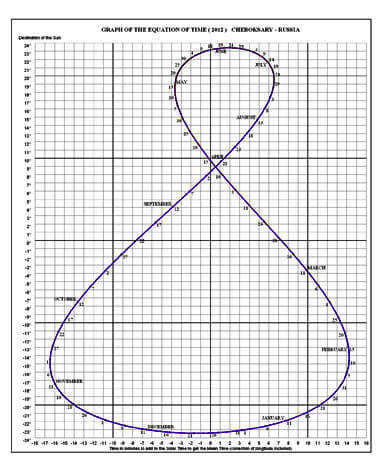
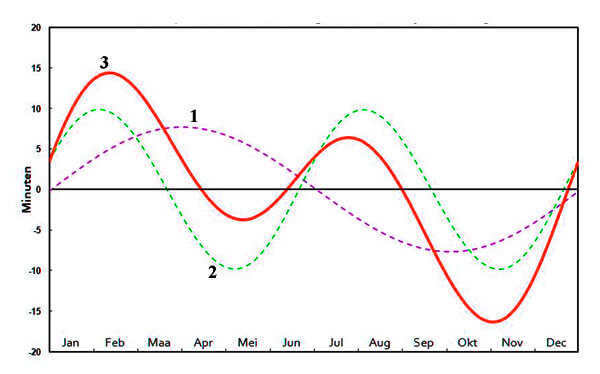
If you disregard this phenomenon, then when navigating in high latitudes, you may encounter an error of approximately four degrees, and in tropical regions, the error can be as high as ten degrees or more.
Methods for determining the exact noon
By determining the exact noon, you can establish the cardinal directions, as the Sun will be directly positioned in the southern or northern hemisphere, depending on the Earth’s axis, and by knowing at least one cardinal direction, you can deduce all the others.
There are several simple methods to determine the exact noon. Here are a few straightforward techniques that don’t require advanced skills or knowledge.
One way to determine the true noon is by using astronomical data. This type of data can often be found in weather forecasts published in various print and online sources. To find the true noon, you need to locate the sunrise and sunset times for the specific area in question. Add these times together and divide the sum in half. The resulting value will be the time of true noon.
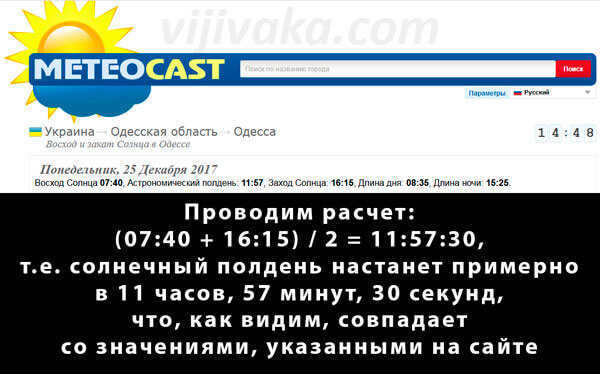
Alternative method #2 – utilizing a sundial (gnomon). A properly designed, marked, and installed sundial can accurately indicate the time of solar noon. The gnomon aligns with twelve hours of the day at the moment of solar noon.
Another option, method #3 – employing a navigator. By indicating the direction towards the geographic north, a navigator can be used to determine the occurrence of true noon. Simply identify the moment when the center of the solar disk is directly above the southern or northern direction (depending on the Earth’s hemisphere), as determined by the navigator. This marks the exact time of true noon.
It is worth noting that a magnetic compass is not particularly useful for this method, as it indicates the direction to magnetic poles rather than geographic poles. This discrepancy can lead to significant errors. For a comprehensive explanation of the differences between true and magnetic poles, please refer to our dedicated article.
Method number 4 – utilizing the aid of a pole’s shadow. Erect a level pole strictly vertically on a level horizontal platform in the ground. Prior to noon, commence measuring the length of the shadow that is cast by the pole on the ground. Initially, the shadow will diminish and then begin to grow. The precise moment when the shadow transitions from shortening to lengthening will signify solar noon.
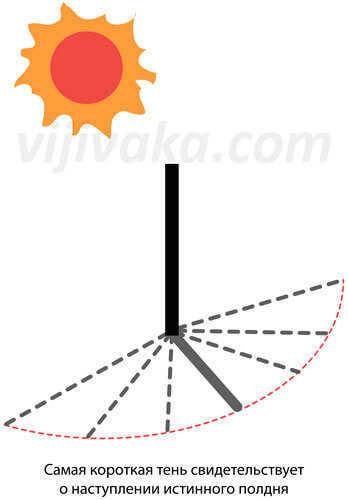

In this variation, it is sufficient to take note of the moment when the shadow is shortest.
This technique is one of the methods of navigation and is commonly recommended in literature for determining the direction of light on the terrain in sunny conditions. Its precision is directly influenced by the levelness of the chosen location and pole, as well as the positioning of the pole. Additionally, the accuracy of the method increases with the length of the pole (typically a pole 1-2 meters long is utilized).
Technique #5 – employing the bisector. Measurements should commence as early as feasible in the morning, enhancing their accuracy. To accomplish this:
- Install a pole on a flat surface, similar to the previous method, and mark the end of its shadow.
- Measure the distance from the pole to this point.
- Draw a circle with a radius equal to this distance, centered at the pole’s installation point. Now, wait for the shadow of the pole to cross this circle again, but in a different location (to the east).
- Once this happens, mark the second point.
- Connect the first and second points with a line – this forms an isosceles triangle, with the pole’s installation point as the third vertex.
- Draw a bisector from the pole’s installation point, dividing the line between the two points in half.
- On the following day, when the shadow cast by the pole aligns perfectly with the bisector, it can be concluded that true noon has arrived.
Similar to the previous method, this technique is also a way to determine direction using the sun.
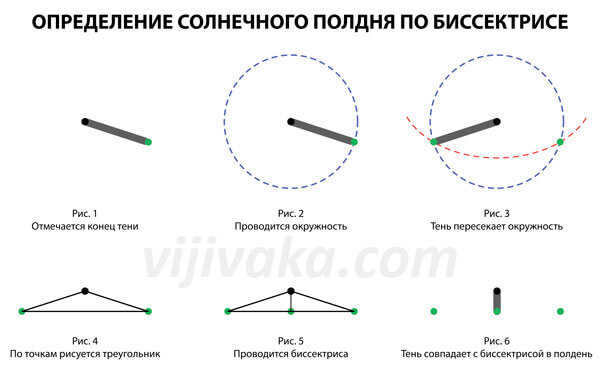

Now, based on all of the aforementioned information and additional data, we will draw some general conclusions.
General Conclusions
The sun always ascends in the east and descends below the horizon in the west. If we align our reference point with a clock, which only slightly deviates from astronomical time, then at 6 a.m. the Sun will be approximately in the eastern direction, by 6 p.m. it will move towards the western direction, and at 12 o’clock, which is midday, it will be approximately in the southern direction. If the clocks are adjusted, corresponding corrections should be made.
It is only possible to orient oneself by the sun during the hours of daylight in clear or lightly cloudy weather.
Generally, orienteering methods that involve using the sun, specifically determining the true noon, enable individuals to identify the cardinal directions, orient a map, and maintain a desired direction of travel even in the absence of a compass, GPS device, and visible landmarks. This skill is highly valuable not only for tourists and hunters, but also for regular individuals who occasionally venture into nature, seeking respite from the noise and chaos of urban environments.
- Midnight, which was originally defined as the middle of the night between sunset and sunrise, represents the moment when the Sun reaches its lowest point in the sky, known as astronomical midnight.
As timekeeping devices such as clocks became more prevalent, the term “midnight” also came to refer to a specific moment in time according to these devices. In modern usage, midnight is considered the beginning of a new day and is denoted as 00:00 according to the officially recognized local time. However, it’s important to note that there can be a difference of one hour or more between the beginning of the day on a clock and the time of astronomical midnight, depending on the configuration of time zones and the potential implementation of daylight saving time in certain countries.
Due to the Earth’s elliptical orbit around the Sun and its tilted axis of rotation, the time of astronomical midnight changes throughout the year, typically within ±15 minutes of the average value (refer to Solar Day and Equation of Time). Therefore, the following concepts are employed:
True midnight refers to the exact moment when the Sun’s diurnal motion reaches its lowest point in the sky.
Similar ideas
An equinox is a phenomenon in astronomy where the Sun’s center, as it appears to move along the ecliptic, crosses the celestial equator.
A solstice, also known as solstevorót in Old Russian, is an astronomical event that marks the highest and lowest positions of the Sun relative to the celestial equator in its visible annual movement on the ecliptic.
The morning is the period of time that follows the night and comes before the day. In the Russian language, the exact time span is not directly associated with the word “morning”. Originally, “morning” referred to the time from sunrise (or dawn), but it is commonly used to describe the time from waking up until noon.
The winter solstice is a significant event in astronomy, occurring when the Earth’s axis tilts away from the Sun, reaching its maximum angle of inclination of 23° 26′. This phenomenon is most noticeable for people living in high latitudes, as it marks the shortest day and the longest night of the year, with the sun rising at its lowest point in the sky.
On the other hand, the summer solstice occurs when the Earth’s axis tilts towards the Sun, reaching its lowest value.
References in literature
The length of the day is determined by the Earth’s rotation around its axis. The measurement of the day varies in different calendars, including the moment of sunrise, sunset, and midnight. In the calendar used in Russia, the day officially begins at midnight.
When the lower part of the daily path of the Sun never goes below the horizon, but instead glides just above it, we experience not only the convergence of two dawns, but also a continuous day. This phenomenon can initially be observed at a latitude of 65°42? where the land of the polar night begins. Even further north, starting from 67°24?, it is also possible to witness a continuous night, where morning twilight merges with evening twilight without passing through midnight. This is known as a “dark day,” the opposite of a white night, although their level of illumination is the same. The land of dark days is the same place as the land of the polar night, just at a different time of year. In the regions where the Sun never sets in June, there is a prolonged darkness in December due to the Sun not rising.
Equally important is the issue of time measurement. It relies on the Earth’s orbit around the Sun and its rotation on its axis. Because the Earth’s orbit is an ellipse, the speed at which the Earth moves along it is uneven, resulting in the uneven pace of the Sun’s apparent movement along the ecliptic. Throughout the day, the Sun crosses the celestial meridian twice during its visible journey. The moment when the center of the Sun crosses the celestial meridian is known as the culmination (from the Latin word “culmen” meaning “top”) of the Sun. This culmination can be either upper or lower. The moment of the upper culmination is referred to as true noon, while the moment of the lower culmination is known as true midnight. The time interval between these two culminations is referred to as half a day. Both the upper and lower culminations can be considered the start or end of the time period (day) that the astrologer selects as the unit.
As per the instructions provided by the members of the observatory, it is recommended to position the cannon, which will launch the projectile, in a location situated between 0 and 28° north or south latitude. This specific positioning will enable the cannon to be aligned with the Moon when it is directly overhead. To ensure a successful launch, the projectile needs to be propelled with an initial velocity of 16,000 meters per second. The launch is scheduled to take place on the evening of December 1st at ten hours and forty seconds. The projectile is expected to reach its destination four days after its departure, precisely at midnight on December 5th. Interestingly, this timing coincides with the Moon’s perigee, which signifies its closest proximity to the Earth.
Further concepts (continuation)
Evening refers to the period of time that follows the day and comes before the night. In some cases, it is associated with the moment when the sun reaches the horizon and twilight begins. However, this occurrence can happen at different times depending on the season.
The time of day is a widely used method for measuring time on Earth, based on the sun’s movement across the sky, which follows an approximate 24-hour cycle.
New Moon, also known as Luna nova or novilunium in Latin, is a phase of the Moon where its ecliptic longitude aligns with that of the Sun. During this phase, the Moon is positioned between the Earth and the Sun, approximately in line with them. If they align perfectly, a solar eclipse takes place.
Rising is the moment when the upper edge of the luminary appears above the horizon. The concept of sunrise can also be defined as the entire process of the visible disk of the luminary crossing the horizon.
Solar day is the duration of time in which a celestial body completes one rotation around its axis in relation to the center of the Sun. More precisely, it is the time interval between two identical (upper or lower) culminations (passages through the meridian) of the center of the Sun at a specific point on the Earth (or another celestial body).
Noon, originally a point in time during the middle of the day, between sunrise and sunset (halfway through the day), is the moment when the Sun reaches its highest point in the sky – solar noon.
Night – a span of time when, for a specific location on the surface of a celestial body (such as a planet or its satellite), the central source of light (such as the Sun or a star) is below the horizon line.
Sunset or sundown is the time when the upper edge of the light source vanishes below the horizon. The concept of sunset can also encompass the entire process of the light source’s visible disk crossing the horizon.
The solar calendar is a type of calendar that is based on the tropical year, which is the period of time in which the seasons change.
A week is a period of time that consists of seven days. In Russian, the seven-day structure of the week is reminiscent of the Church Slavonic word Sedmitsa.
Modern measurements of time are derived from the Earth’s rotation and revolution around the Sun, as well as the Moon’s revolution around the Earth. This choice of units is based on both historical and practical reasons, as it allows for the synchronization of human activity with the natural cycles of day and night and the changing seasons.
Moon phases refer to the periodic changes in the illuminated portion of the Moon as observed from Earth. These phases gradually and cyclically change over the course of a synodic month, which is approximately 29.5306 solar days. The specific phase of the Moon is also influenced by its orbital position as it orbits the Earth and the Earth orbits the Sun.
Tuesday is the day of the week that falls between Monday and Wednesday. According to the international standard ISO 8601, it is considered the second day of the week, although some traditions view it as the third.
The Full Moon, also known as Luna plena or plenilunium in Latin, is a lunar phase when the difference between the Sun and Moon’s ecliptic longitudes is 180°. This alignment creates a perpendicular plane between the Sun, Earth, and Moon along the ecliptic plane. When all three celestial bodies are in line, a lunar eclipse occurs. During a full moon, the Moon appears as a fully illuminated circle.
Dawn is a natural phenomenon that occurs before sunrise. It is characterized by the gradual increase in environmental illumination as the Sun’s disk rises above the horizon line.
The calendar (originally derived from the Latin word calendarium, which means debt book, as in ancient Rome debtors paid interest on the calends, the first of the month) is a method of measuring significant time periods based on the regularity of celestial bodies’ movements, such as the Sun in solar calendars, the Moon in lunar calendars, and both the Sun and the Moon in luni-solar calendars. Additionally, a calendar is a compilation of the days in a year, organized into weeks and months, and indicating holidays. It can also be a recurring reference book that contains a sequential arrangement of dates.
The Julian Date (JD) is a method used in astronomy to measure time. It calculates the number of days that have passed since noon on Monday, January 1, 4713 BCE in the Julian calendar, or November 24, 4714 BCE in the Gregorian calendar (which correspond to -4712 and -4713 in astronomical year counting). The first day was assigned the number 0. Since then, approximately 2.5 million days have elapsed. Dates change at noon UT or TT. They use this method to accurately mark the passage of time.
The lunar calendar is a calendar that is based on the changing phases of the moon, known as the synodic month.
Culmination in astronomy refers to the moment when the center of a celestial body passes through the celestial meridian during its daily movement. It can also refer to the point where the center of a celestial body intersects with the daily parallel of the luminary and the celestial meridian.
The luni-solar calendar is a calendar that is based on the regular movements of the Moon and the Sun.
The Metonic cycle is a period of time that lasts for 6939 days, 14 hours, and 15 minutes. It is used to synchronize the length of the lunar month and the solar year in the luni-solar calendar. This cycle was first proposed by the Athenian astronomer Methon in 433 BC and was the foundation of the ancient Greek calendar. The Methon cycle is based on the approximate equality of 19 tropical years and 235 synodic months, meaning that every 19 years, the lunar cycle ends on the same day as the solar year.
Civil time is a system of keeping track of time that is based on the average solar day and starts at local midnight.
Stellar periods are the durations of rotation for celestial bodies around their own axes in an inertial frame of reference, typically taken as the frame of reference associated with distant stars. For our planet, it represents the time it takes for the Earth to complete one full rotation on its axis relative to distant stars.
Twilight refers to the period of time when the Sun is situated below the horizon, and natural lighting on Earth comes from the reflection of sunlight off the upper atmosphere and the residual glow emitted by the atmosphere itself due to ionizing radiation from the Sun.
Universal Time, also known as UT, is a time measurement system that is based on the rotation of the Earth. UT serves as a modern replacement for Greenwich Mean Time (GMT), which is sometimes mistakenly used interchangeably with Coordinated Universal Time (UTC). The concept of Universal Time was first introduced on January 1, 1925. It’s important to note that the term “Universal Time” has multiple meanings, with the main versions being UT1 and UTC (more information on these versions can be found below).
Longitude of the day refers to the period of time between sunrise and sunset, when at least a portion of the sun’s disk is visible above the horizon.
Heliacal (heliacal) sunrise (derived from the Greek word ἡλιακός meaning solar) refers to the first appearance of a celestial body (such as a star or planet) after a period of being invisible just before sunrise. It can be described as the moment when the sun’s rays break through the morning dawn.
A leap year (derived from the Latin term bis sextus meaning “second sixth”) is a calendar year that contains an additional day in solar calendars. In luni-solar calendars, a leap year may include an extra month to ensure synchronization with the astronomical or seasonal year. A year that does not have an additional day or month is known as a non-leap year.
The terms “World Calendar”, “Permanent Calendar” and “Stable Calendar” refer to the same concept and are redirected to this page. A stable calendar, also known as a permanent calendar or world calendar, is a calendar system that offers improved coordination of day numbers, days of the week, months, and years compared to the Gregorian calendar. In this system, each day of the year is assigned a permanent day of the week. Numerous proposals for stable calendars have been made, including the Armelin calendar, which was discussed at the United Nations in 1953-1954.
The Roman calendar, used in both the Roman Empire and Republic, encompasses the Julian calendar as well. The Julian calendar was implemented through reforms enacted by dictator Julius Caesar and Emperor Augustus in the late first century BC.
New Year’s Day is the primary holiday on the calendar that occurs when the last day of the year transitions to the first day of the next year. It is celebrated by many countries following their respective calendars.
A fortnight (derived from “fourteen nights”) is a time measurement equal to two weeks, or precisely 14 days. This unit is commonly used in the United Kingdom and Australia, but rarely used in the United States.
White nights refer to nights in which there is enough natural light, such as twilight, throughout the entire night. This phenomenon is observed in temperate and high latitudes before and after the summer solstice.
The Darius calendar, developed by aerospace engineer and political scientist Thomas Gangale in 1985, offers a unique system for measuring time on Mars, which could be useful for future settlers on the red planet. The calendar is named after Gangale’s son, Darius.
Mesyats, derived from the Latin word “mēnsis” and the Greek word “μήνας,” is a unit of time measurement that is not part of the standard system. It is associated with the moon’s revolution around the Earth.
Zytglogge, also known as the Clock Tower, is a medieval clock tower located in the historic area of Bern. It features an astronomical clock that has been in operation since ancient times.
A cotidal line is an isoline on a cotidal map of the Earth’s surface, which is determined by the geometric positioning of points with the same tidal phases. Each cotidal line is labeled with the corresponding hour of lunar time at Greenwich, known as quotidal, which represents the number of lunar hours (equivalent to 1 hour and 2 minutes of mean solar time) that have passed since the Moon reached its highest point in the sky in Greenwich to the start of high tide.
The Inca Calendar is a calendar system developed by the Inca civilization during the pre-Columbian era. It encompasses both solar and lunar astronomical calendars.
A sundial is an instrument used to measure time based on the changing length and movement of the shadow cast by the gnomon on the dial. The design of this timepiece is closely tied to the moment when humans first recognized the correlation between the length and position of the sun’s shadow on various objects and the sun’s position in the sky.
Further Mentions in Literature
According to a recent entry in the records of the observatory astronomers, it has been determined that the optimal location for the firing of the projectile, which will carry the brave adventurers to the Moon, is within the range of 0° to 28° north or south latitude. Furthermore, the gun must be aimed directly at the Moon when it is at its highest point in the sky, known as the zenith. To ensure a successful journey, the projectile must possess an initial velocity of an impressive 12,000 yards per second.
In accordance with the meticulously planned schedule, the projectile is set to be launched on the evening of December 1st, precisely at 10:46:40 PM. It is projected to reach its destination, the Moon, a mere four days after its departure. This auspicious event is predicted to occur on December 5th, at the stroke of midnight. Coincidentally, this moment will also mark the Moon’s closest proximity to the Earth, a phenomenon commonly referred to as perigee. At this juncture, the Moon will be a mere 86,410 leagues away from our planet.
The query is prone to puzzle: as one side of the Earth is always illuminated by sunlight while the other is shrouded in darkness, what is the significance of our inquiry? Seemingly, none. However, that is not the case. The inquiry does not concern the Earth’s overall movement, but rather our own movement among the stars as its inhabitants. And this question holds meaning. Within the solar system, we engage in two types of movement: we orbit the Sun and simultaneously rotate around the Earth’s axis. Both motions combine, but the outcome varies depending on whether we find ourselves on the illuminated or shadowed portion of the Earth. Refer to Fig. 6, and you will grasp that at midnight, the rotational velocity is added to the translational velocity of the Earth, while at noon, it is subtracted. Consequently, at midnight, our movement in the solar system is swifter compared to noon.
Based on the above information, the first step is to determine the specific time when the moon will be at its closest point to the Earth, known as perigee. Additionally, it is important to identify the moment when the moon will be directly overhead, known as the zenith. By subtracting the radius of the Earth, which is 3,919 miles, from the distance between the moon and the Earth, the length of the projectile’s path can be calculated to be approximately 214,976 miles. However, it is worth noting that while the moon reaches perigee every month, it is not always at the zenith during that time. This particular alignment occurs at longer intervals. As a result, it is necessary to wait for the specific moment when the moon is at both perigee and zenith. Fortunately, this rare alignment will happen on December 4th of the following year. At exactly midnight, the moon will be at its perigee, the closest point to the Earth, and at the same time, it will also be in the zenith position.
There is an alternative solution to this issue: simply be patient and wait. Eventually, life will naturally adjust its course to accommodate your daily routine. Research has shown that throughout our lives, we undergo self-driven changes in our behavior and gradually transition from being “night owls” to becoming early risers, or “larks”. According to statistics, nearly half of individuals aged 20 to 30 are night owls, while approximately 20% of those aged 30 to 50 still prefer a nocturnal lifestyle. However, as we reach our fifties, very few people are capable of staying awake past midnight.
In Egypt, the length of the day was not 12 hours but 10 hours. Additionally, not everyone started their day with sunrise. The Jews, Gauls, Chinese, and Muslims all began their day at sunset, which meant that the night came before the day. The pre-Islamic Arabs, on the other hand, started their day at noon. The Romans, similar to today, started their day at midnight. The tradition of starting a new day at midnight originated from ancient Rome, although in ancient times, the night was still considered the first half of the day.
In the midnight ephemerides, which we will discuss further, the position of the planets is indicated at 0 o’clock. However, the question arises: what time is that? When it is midnight in Moscow, it is 9 a.m. in Petropavlovsk-Kamchatsky, and in New York, it is only 4 p.m. in the afternoon.
Imagine the incredible scenario where we have successfully constructed a spaceship capable of traveling faster than the speed of light. It is well understood that when analyzing the effects of relativity, we must consider the rocket’s journey in two different coordinate systems. The first system, let’s call it the Earth’s surface, represents the spaceport from which the rocket was launched. In this frame of reference, everything proceeds as usual: the rocket takes off at noon and, astonishingly, reaches its destination at five times the speed of light by midnight.
The Tunguska meteorite explosion may have been one of the most significant disasters in recent times, resulting from the impact of a celestial object on Earth. Its effects extended beyond Siberia, reaching even as far as Great Britain. As a result, the evening sky above London was illuminated, providing enough light for people to comfortably read the newspaper while strolling through the unlit streets at midnight.
- Midday, which was originally defined as the time in the middle of the day between sunrise and sunset (half day), represents the moment when the Sun reaches its highest point in the sky – also known as solar noon.
Related concepts
The summer solstice occurs when the Earth’s axis of rotation is tilted the furthest towards the Sun.
Solstice (also known as Solnevorót in Old Russian) is an astronomical event that marks the Sun’s highest and lowest positions relative to the celestial equator during its yearly movement along the ecliptic.
Midnight, on the other hand, is originally defined as the time in the middle of the night between sunset and sunrise (half of the night), and represents the moment when the Sun reaches its lowest point in the sky – also known as astronomical midnight.
Equinox is a celestial event that happens when the center of the Sun, in its apparent movement along the ecliptic, intersects the celestial equator.
Winter Solstice is a celestial event that occurs when the tilt of the Earth’s axis of rotation is oriented away from the Sun to its greatest extent. The maximum angle of inclination of the Earth’s axis relative to the Sun during the solstice is 23° 26′. For people living in high latitudes, it is more noticeable that the winter solstice marks the shortest day and longest night of the year, with the lowest height of the sun’s rise in the sky.
References in literature
As we are aware, the Earth completes a full rotation around its axis within a 24-hour period. Consequently, one side of the Earth experiences daylight while the other side experiences darkness. Every hour, the Earth rotates 15 degrees in longitude. Consequently, the solar noon, which is the moment when the sun reaches its highest point above the horizon, occurs approximately an hour later in St. Petersburg compared to Kostroma.
Let’s examine the diagram (Fig. 14, a). Assume that the observer is positioned at point M, and point N represents the North Pole. The circle HASNRBQ, known as the celestial meridian, intersects the observer’s zenith and the North Pole. Determining the observer’s latitude is a simple task; one can measure the angle between the pole and the horizon line NR using a protractor, which will give us the latitude of the location.[4] When looking from M towards N, the observer faces the southern direction. On this diagram, the Sun’s daily path is represented by a straight line, with a portion above the horizon line (day path) and a portion below it (night path). The line AQ depicts the Sun’s path on the days of the equinoxes; as shown, the daytime path is equal to the nighttime path. SB represents the Sun’s path in summer, parallel to AQ but with most of it above the horizon and only a small part (recall the short summer nights) below the horizon. On these circles, the Sun completes one 24th fraction of its total length every hour, equivalent to 360°/24=15°. However, three hours after noon, the Sun does not align with the southwest point of the horizon, as one might anticipate (15° x 3 = 45°); this discrepancy arises because the projections of equal segments of the solar path onto the plane of the horizon are not of equal length.
Equally important is the issue of time measurement. It is determined by the Earth’s rotation around the Sun and its own axis. Since the Earth’s orbit is elliptical, its speed along the orbit is not constant, which means that the apparent speed of the Sun’s motion along the ecliptic is also variable. The celestial bodies, during the course of a day, cross the celestial meridian twice in their visible movement. The moment when the center of a celestial body crosses the celestial meridian is referred to as the culmination, derived from the Latin word “culmen” meaning “top”. There can be both upper and lower culminations. The moment of the first crossing is known as true noon, while the moment of the second crossing is known as true midnight. The time interval between these two culminations is referred to as half-day. Both upper and lower culminations can be considered as the starting or ending point for the time interval (day) that the astrologer selects as a unit.
The position of the Sun in the sky has been used since ancient times to determine time. When the Sun reaches its highest point, it signifies noon. This method, known as the sundial, provides us with local time, which is the most natural way to measure time.
Further Related Concepts
Zone time refers to the time of a specific time zone. It can be understood in two ways: geographically and administratively.
Sunrise, on the other hand, is the exact moment when the upper edge of a celestial body appears above the horizon. Additionally, sunrise can also encompass the entire process of the celestial body crossing the horizon.
A long day is the duration between sunrise and sunset, during which a portion of the sun’s disk remains above the horizon.
White nights refer to nights where natural light remains relatively high, resulting in twilight throughout the entire night. This phenomenon is commonly observed in regions with temperate and high latitudes, occurring before and after the summer solstice.
Sunset, also known as sundown, refers to the moment when the upper edge of the sun disappears below the horizon. The term sunset can also encompass the entire process of the sun’s visible disk crossing the horizon.
Culmination in astronomy refers to the moment when the center of the sun passes through the celestial meridian during its daily movement. It can also refer to the passage of the sun’s center through the point where its daily path intersects with the celestial meridian.
Morning is the time period that follows the night and precedes the day. In the Russian language, there is no exact time associated with the word “morning.” Originally, “morning” was defined as the period from sunrise or dawn, but nowadays it usually refers to the time from waking up until noon.
Solar days are a specific duration in which a celestial body completes one full rotation around its axis in relation to the center of the Sun. More specifically, it is the time between two instances of the Sun’s center passing through the meridian (upper or lower culmination) at a specific point on Earth (or another celestial body).
A tropical year, also known as a solar year, is the overall period of time in which the Sun completes a full cycle of the changing seasons as observed from Earth. This includes the time between one vernal equinox and the next, or from one summer solstice to the following one. Over time, astronomers have refined the definition of a tropical year to be the specific amount of time it takes for the mean tropical longitude of the Sun to complete its cycle.
A prime meridian serves as the starting point for measuring geographic longitude. In the accepted reference system, the longitude of this meridian is defined as zero degrees.
The New Moon, also known as Luna nova or novilunium in Latin, occurs when the Moon’s ecliptic longitude matches that of the Sun. During this phase, the Moon is positioned between the Earth and the Sun along a straight line. If they align perfectly, a solar eclipse takes place.
The measurement of time on Earth relies on the position of the sun in the sky, which changes periodically over the course of a day. This method is widely used for determining the time of day.
Daylight Saving Time is a practice of adjusting clocks forward in the spring and back in the fall. This is done to make better use of daylight during the summer months. In most countries, clocks are set one hour ahead in the spring and then set back one hour in the fall. This practice is commonly known as “springing forward” and “falling back.” The change back to standard time usually occurs on Saturday night.
The term “night” refers to the period of time when the sun or other central luminary is below the horizon line. This is the time when darkness falls and the stars come out.
Civil time is a time measurement system that is based on the average solar day, starting from local midnight.
Evening refers to the period of time between day and night. It is often marked by the sun descending below the horizon and the onset of twilight, although the exact timing can vary depending on the season.
A solar clock is a device that uses the length and movement of a shadow cast by a gnomon to determine the time. This type of clock was developed when people began to understand the relationship between the length and position of the sun’s shadow and the sun’s position in the sky.
Europe is divided into 7 major time zones, ranging from UTC-01:00 to UTC+05:00. These time zones do not take into account Daylight Saving Time. On the map to the right, you can see 4 of these time zones, while one of them is located to the west and does not fit on the map. This particular time zone is used in the Azores, as well as in regions like Georgia, Azerbaijan, the European part of Russia, and Kazakhstan. It’s worth noting that most European countries observe Daylight Saving Time. If you’re interested in learning more about Summer Time in Europe, you can refer to GMT.
When it comes to measuring time related to the Moon’s revolution around the Earth, the Russian term for a month is “Mesyats” (мес.). This word derives from Latin mēnsis and Greek μήνας.
The duration of a celestial body’s rotation around its own axis in an inertial frame of reference, typically the frame associated with distant stars, is known as stellar days. For Earth, it refers to the time it takes for one complete revolution around its axis in relation to distant stars.
Modern time units are based on Earth’s rotation around its axis, its revolution around the Sun, and the Moon’s revolution around Earth. This choice of units is influenced by both historical and practical considerations, such as the need to coordinate human activities with day and night cycles and changing seasons.
Solar maximum is the phase in a solar cycle characterized by the highest level of solar activity. It is during this period that the greatest number of sunspots are observed on the surface of the Sun.
Bessel’s year (named after the German astronomer F. Bessel who lived in the 19th century) is a type of tropical year. It starts when the mean longitude of the Sun, after being adjusted by a constant aberration factor of 20.496 arc seconds, reaches exactly 280 degrees. The start of a Besselian year is the same for every location on Earth. The length of a non-tropical year is the same as a tropical year and can be calculated in days using the formula T₀ = 365.24219879 – 0.00000614T, where T represents a certain value.
A fortnight, which comes from the Old English phrase “fēowertēne niht” meaning fourteen nights, is a unit of time equivalent to two weeks or 14 days (specifically, 14 nights). This unit is commonly used in Great Britain and Australia, but is rarely used in the United States.
The initial period (known as Luna crescens dimidiata in Latin) is when precisely half of the visible portion of the Moon is illuminated. Unlike the final stage, the amount of illuminated area is increasing during this phase, signifying the Moon’s transition from a new moon to a full moon. During this phase, the Moon is positioned in the eastern quadrature, meaning that the angular distance between the Moon and the Sun is 90°. The Moon is located to the east of the Sun, resulting in the illumination of the western section of the Moon’s visible side.
An hour (Russian: h; international: h) is a non-system unit of time measurement. Per the contemporary definition, an hour is precisely equivalent to 3600 seconds, which corresponds to 60 minutes or 1/24 of a day. The academic hour spans 45 minutes. The “Quiet Hour” or “Dead Hour” in hospitals, rest homes, and children’s institutions (kindergartens, camps) lasts for 120 minutes.
The date line is a conventional line that stretches from one pole to another on the Earth’s surface. It divides the globe into two sides where the local time differs by about a day. In other words, the clocks on either side of the line show roughly the same time of day (with a potential difference of one to three hours due to time zone shifts), but the date is shifted one day ahead on the western side compared to the eastern side. To put it differently, when crossing the date line, the date changes.
Venus’ transit of the Sun is a special event in astronomy where the planet Venus aligns perfectly between the Sun and Earth, creating a small black spot on the solar disk. This phenomenon is similar to a solar eclipse, when the Moon blocks out the Sun, but Venus is much larger than the Moon. During the transit, Venus appears about 4 times larger than the Moon.
Earth branches, also known as “地支 dìzhī” in Chinese, are part of a cyclic system used in China and other southeast Asian countries for measuring time and as important elements in classical Chinese metaphysics.
The Dari calendar, which was developed by aerospace engineer and political scientist Thomas Gangale in 1985 and named after his son Darius, is a suggested time measurement system for settlers on Mars.
In the historic area of Bern, you can find the Zytglogge, also known as the Clock Tower. This medieval clock tower features an astronomical clock.
The polar night occurs when the Sun remains below the horizon for more than 24 hours, which is equivalent to more than a day. The shortest polar night, lasting nearly two days, is observed at a latitude of approximately 67°24′N. This latitude is defined as the Arctic Circle, which is approximately 66°34′N, plus the radius of the solar disk (about 15′) and the value of atmospheric refraction (approximately 35′) at sea level on average. On the other hand, the longest polar night occurs at the South Pole and lasts for slightly less than six months. The polar night is a result of the Earth’s axis of rotation being tilted.
A planetary parade is an astronomical phenomenon where multiple planets in the solar system align on the same side of the Sun within a small portion of the celestial sphere. During this event, the planets are relatively close to each other in terms of their positions in the sky.
The equation of time represents the discrepancy between mean solar time (MSW) and true solar time (TSW), which can be expressed as SU = MSW – TSW. This difference remains constant for any observer on Earth at a specific moment in time. The equation of time can be obtained from specialized astronomical publications, astronomical programs, or calculated using the following formula.
Heliacal sunrise, also known as heliacal rising, refers to the first appearance of a celestial luminary (such as a star or planet) after a period of invisibility just before sunrise. It is often described as “sunrise in the rays of the morning dawn.”
Mercury, the smallest of the terrestrial planets, holds the distinction of being the closest planet to the Sun in our Solar System. It is named after the swift Roman god of commerce, Mercury, due to its rapid movement across the celestial sphere compared to other planets.
Solar activity is a combination of various phenomena and processes that are connected to the creation and dissolution of powerful magnetic fields in the atmosphere of the Sun.
The New Earth effect is one of the three optical illusions that occur in the Arctic (the other two being hillingar and hafgerdingar), which are caused by the bending of sunlight in different layers of air with varying temperatures. These illusions can be observed both in the Arctic and Antarctic regions.
The Moon is a natural satellite of the Earth and is the closest satellite to the Sun. Unlike the closest planets to the Sun, Mercury and Venus, the Earth has a natural satellite. The Moon is the second brightest object in the Earth’s sky, after the Sun, and is the fifth largest natural satellite in the Solar System. The average distance between the centers of the Earth and the Moon is 384,467 km (0.00257 astronomical units, approximately 30 Earth diameters).
Further mentions in the literary works
5. The measurement of time based on the position of the sun was not problematic in the past when transportation and communication were limited. However, the development of the railroad system in the late 19th century brought about the need for a standardized time. This led to the implementation of Central European time, which is a fictional representation of the sun’s path. The fictional sun’s path is an average and does not exactly align with the real sun. There are only a few days in the year when the fictional and real sun coincide: April 16, June 15, September 1, and December 25. The introduction of daylight saving time, where clocks are moved one hour forward from March to October, has further increased the discrepancy between the fictional and real sun. Now, the fictional and real sun only align at noon on December 25.
The approach of the storm was first detected at the Nikolaev Main Physical Observatory on November 11th, when meteorological data from Western Europe started to come in. On the weather map at 7 a.m., a significant drop in barometric pressure (below 735 mm) was observed to the west of Stockholm. By noon on the 11th, the observatory had issued storm warnings to the lakes and Kronstadt, and a storm signal was raised in St. Petersburg. The barometer in the city was falling at a rate of over 2 mm per hour, reaching a minimum atmospheric pressure of 734 mm at midnight. The rise in water levels began around 1:00 am, accompanied by strong winds that intensified into a full-blown storm by morning, with a slight shift in wind direction towards the north. Once the water levels reached their peak, they began to recede, dropping to 6 feet by 2 pm. Meanwhile, the barometer rose to 746 mm. By the evening of the 12th, the Neva River had returned to its normal levels.
Due to the fact that the equator’s points travel at approximately half a kilometer per second, the velocity difference between noon and midnight in the equatorial region amounts to a full kilometer per second. Individuals with knowledge of geometry can easily determine that for Leningrad (which is situated on the 60th parallel), this difference is half as large: at midnight, residents of Leningrad move through the solar system half a kilometer further per second compared to noon.
Assuming that we have achieved the remarkable feat of constructing a spaceship capable of traveling faster than the speed of light, let’s consider the analysis of relativistic effects in the context of two coordinate systems. The first one, which we will designate as the Earth surface or the spaceport from where the rocket is launched, operates under normal conditions. In this frame of reference, the rocket takes off at noon and reaches its destination, let’s say, at the next midnight, traveling at a speed five times faster than the speed of light.
Mars is not as warm as Earth. It receives 2.15 times less solar energy. Even in the hottest zone at the equator, the temperature rarely exceeds 0° at noon and plummets to minus 100° at night. The polar regions are even colder. Liquid water is absent on Mars. The atmosphere is extremely thin, often giving rise to winds and even hurricanes. The composition of the Martian soil was analyzed using samples collected by the American Viking-1 and Viking-2 stations. The studies have revealed the absence of any microorganisms on Mars, indicating the lack of life on the planet.
Typically, the start of the wet season is marked by heavy fumes in the morning. As the day progresses, the air becomes unbearably stuffy and saturated with vapors. The sun, resembling a tennis ball, emerges from the water around 7 AM and remains high in the sky, scorching mercilessly until sunset. Each afternoon, like clockwork, the summer monsoon brings warm and humid air from the Indian Ocean, resulting in rainfall on the mainland. Within an hour of the downpour, all traces of water vanish from the city and roads. Any remaining water that doesn’t soak into the ground or flow into the fields, which transform into lakes and rivers during the rainy season, evaporates back into the air, saturating it with vapors. By six o’clock in the evening, the sun swiftly disappears below the horizon, giving way to a star-filled darkness.
Prior to the reign of George II (1727-1760), individuals did not travel faster than they did in the first century B.C. However, this all changed after 1784, when John Palmer, a member of Parliament from Bath, established the first scheduled public transportation system in Britain. His stagecoaches would depart from Bath in the afternoon, travel throughout the night, and arrive at the main post office in Lombard Street by eight o’clock the following morning.
During the night of 1966 on the moon, the English astronomer P. Moore made an intriguing discovery. While observing the bottom of a lunar crater, he noticed peculiar streaks that transitioned from a dark color to greenish-brown. These streaks then diverged in radii, changed shape, and grew larger until reaching their maximum size by lunar noon. As the lunar evening approached, the streaks began to shrink, fade away, and eventually vanished completely.
"According to Solius Polychostrus, the Hyperboreans had a unique agricultural system. They would sow their crops in the morning, reap them at noon, and then harvest the fruits in the evening. To preserve their harvest, they would store them in their caves during the night. It is important to note that this cycle of farming and storing takes into account the polar day and night experienced in these regions. Historical texts reveal that the climate in these areas has undergone multiple changes since humans first inhabited them. These once paradisiacal lands have transformed into harsh environments, reminiscent of the Greek concept of Hades and the cold underworld ruled by the Scandinavian Goddess Hel. However, it is worth mentioning that this region holds significance as the birthplace of Apollo, the radiant God of Heaven." [5, 976].

